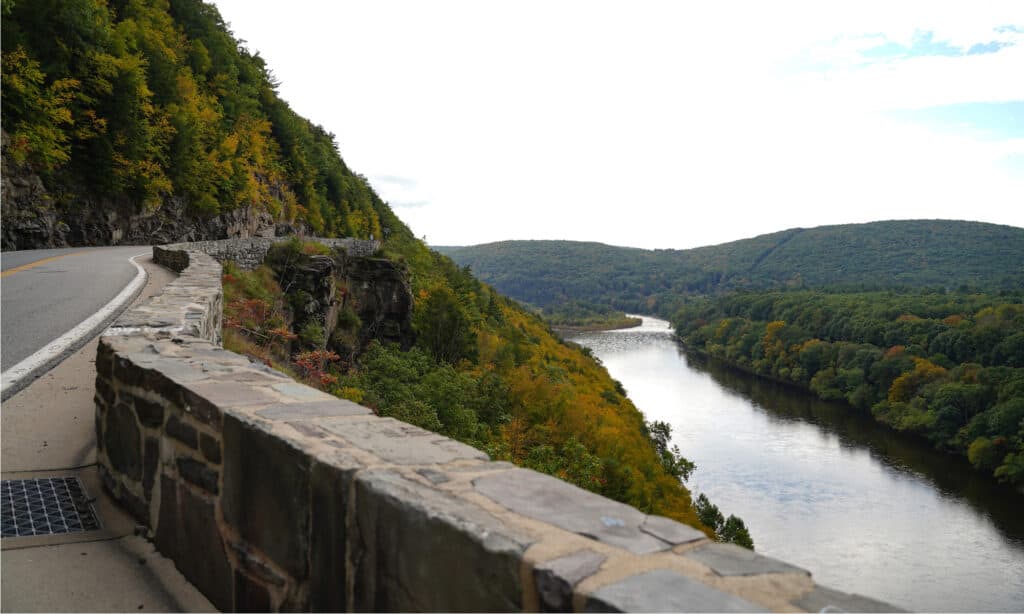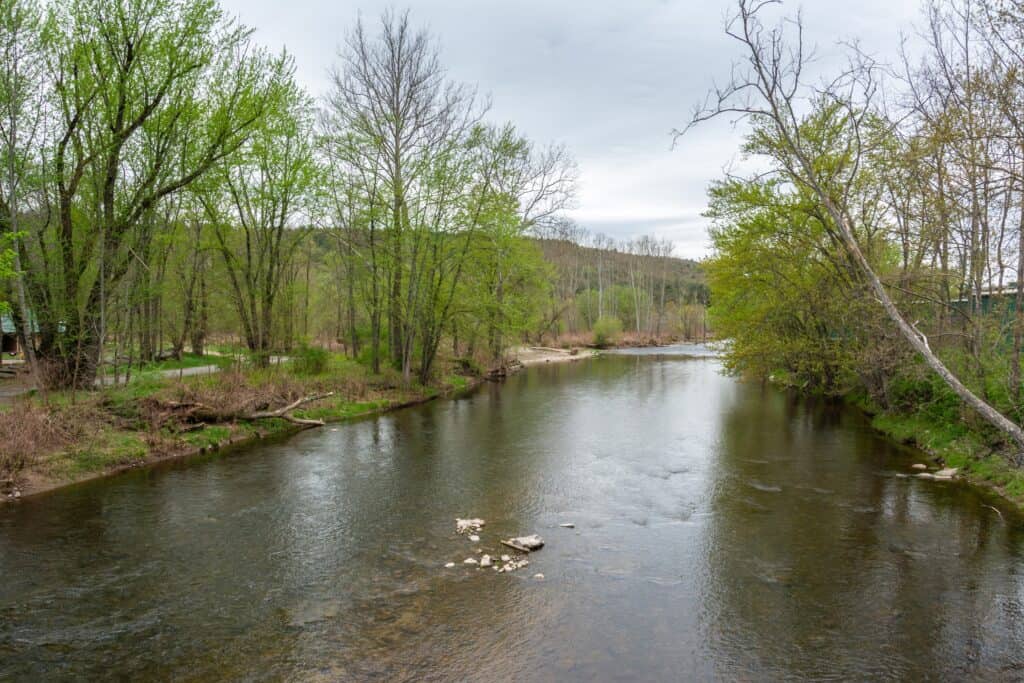
The Delaware River reaches a width of 3 to 4 miles at its widest point. Although it is not as wide as the Mississippi or Missouri, it is still impressive, with a discharge volume of 11,550 cubic feet per second.
Also, the Delaware River is among the 19 esteemed “Great Waters” of America’s Great Waters Coalition. This majestic river is the lifeblood of many along its path. So, in this article, we delve into some interesting aspects that are unique to the Delaware River, Atlantic coast, U.S.

How wide is the Delaware River at its widest point? The Delaware River is 3 to 4 miles wide at its widest point, flows for 330 miles, and discharges 11,550 cubic feet per second into the Atlantic.
©vm2002/Shutterstock.com
What Distance Does the Delaware River Basin Cover?
The Delaware River basin embodies an impressive 13,600 square miles. Its 330-mile flow begins in New York State and ends at its confluence with the Atlantic Ocean. A significant feature of this basin is that its watershed spans 12,800 square miles of land mass. Of this, 18% is agricultural land, 14% is developed, and 68% is forested land.
How Large is the Delaware Rivers Drainage Basin?
The Delaware River’s drainage basin covers an area of 13,539 square miles. Its drainage area encompasses New York, New Jersey, Pennsylvania, Maryland, and Delaware. Additionally, these five states extend over 42 counties and 838 municipalities.
How Many Gallons of Water Does the Delaware River Basin Provide per Day?
The Delaware River Basin reservoir’s capacity is an astounding 95.7 billion U.S. gallons. As the 33rd largest river in the U.S., Delaware is the nation’s most heavily used river in terms of daily volume.
People and industries use an average of 8.7 billion gallons of Delaware basin water daily. Of this tally, officials export 736 million gallons of water to New York City and New Jersey alone. These exports account for close to 10% of the total water withdrawals from this river basin.
Interestingly, authorities divert 90% of water withdrawn from the Delaware basin from surface water flows.
Does the Delaware River Basin Supply Drinking Water Along Its Watershed?
The river basin supplies 17 million people with drinking water. That figure makes up approximately 6% of the population of the U.S. The drinking or potable water in the Delaware River basin is supplied by 64% surface water diversions, while 34% is through groundwater withdrawal. Ninety percent of potable water provisions go to commercial and residential sectors via public water systems. Privately owned or domestic well owners provide the residual 10%.
How Many Tributaries Drain Into the Delaware River?

Callicoon Creek is one of the Delaware River’s main tributaries in
New York State
.
©Alizada Studios/Shutterstock.com
Two hundred and sixteen major tributary rivers, streams, and creeks drain into the Delaware River. However, in totality, the Delaware River is fed by more than 2,000 different feeders. This network encompasses about 14,057 miles of waterways in the river’s watershed.
The Delaware Rivers’ main tributaries in New York are the following:
- Mongaup River
- Neversink River
- Callicoon Creek
The main tributaries in Pennsylvania are:
- Lackawaxen River
- Lehigh River
- Schuylkill River
The main tributaries in New Jersey are:
- Musconetcong Creek
- Rancocas Creek
- Cooper River
- Maurice River
How Fast Does the Delaware Flow?
The Delaware River can reach a speed of 6 to 7 miles per hour at the flooding stage. So, the river flows in direct proportion to local rainfall. Its flow also relies on reservoir releases, and deposits from tributaries, proving that they are temperamental and constantly changing. Because of this, the U.S. Geological Survey National Streamflow Information Program helps those in surrounding areas keep abreast of river situations.
Clearly, the speed and conditions of the river will vary at different points of elevation. For example, the Delaware River Basin Commission advises that river currents between 2.5 and 4 feet can flow at approximately two miles per hour. From four to 12 feet, the variance in flow rises incrementally from 2.5 miles to 6 or 7 miles per hour.
Why is Delaware Bay Significant to the Delaware River?
Cape Henlopen and Cape May separate the 782 square mile Delaware Bay from the Atlantic Ocean. The bay lies along the borders of the New Jersey and Delaware states.
Delaware Bay is a major estuary outlet of the Delaware River. The bay is where the freshwater river supplied by the Delaware River merges into the maritime waters of the Atlantic Ocean.
Beyond the Delaware River, numerous smaller streams feed the bay. Several of these rivers are conservation areas. Conservationists protect these areas for their unique salt marsh wetlands, which serve as a rich breeding ground for many aquatic species. These species include oysters and horseshoe crabs.
Which Animals Live in the Delaware River?

Raccoons also live
along the wide Delaware River.
©iStock.com/JZHunt
The Delaware River and its feeders support a massive variety of wildlife. With habitats varying from rivers and ponds to lush riverbanks, Delaware is home to otters, tiny ruby-throated hummingbirds, owls, and six species of bats. Also, foxes, coyotes, bobcats, and raccoons prowl around the river when hunting.
Notably, this river is also teeming with more than 60 fish species. In addition, migratory species such as eels and shad use the river for swimming between the river and the ocean. Moreover, birds like the blue and green-backed herons live among the the river’s shallows. The river provides the perfect feeding grounds for its amphibian and crustaceans dwellers.
What Is the Delaware Water Gap?
The famous Delaware Water Gap is an opening where the flow of the Delaware River has cut through a ridge in the Appalachian Mountains. The Kittatinny Ridge is an area between New Jersey and Pennsylvania.
The Delaware Water Gap encompasses 70,000 acres and 40 miles of the Delaware River. This picturesque, forested area winds through the Appalachian Mountains, and a beautiful national park at Kittatinny Point, New Jersey, provides ample recreational activities. With a magnificent waterfall as a backdrop, visitors enjoy everything from canoeing to fishing and cross-country in this environment.
It would be accurate to state that the Delaware is the lifeblood of the North-eastern seaboard of the U.S.
Where is the Delaware River Located on a Map?
The Delaware River is a significant river located in the Mid-Atlantic region of the United States, stretching 282 miles from its confluence in Hancock, New York, and tracing the borders of New York, Pennsylvania, New Jersey, and Delaware until it reaches its endpoint at Delaware Bay.
Here is the Delaware River on a map:
The photo featured at the top of this post is © Paul Brady Photography/Shutterstock.com
Thank you for reading! Have some feedback for us? Contact the AZ Animals editorial team.







